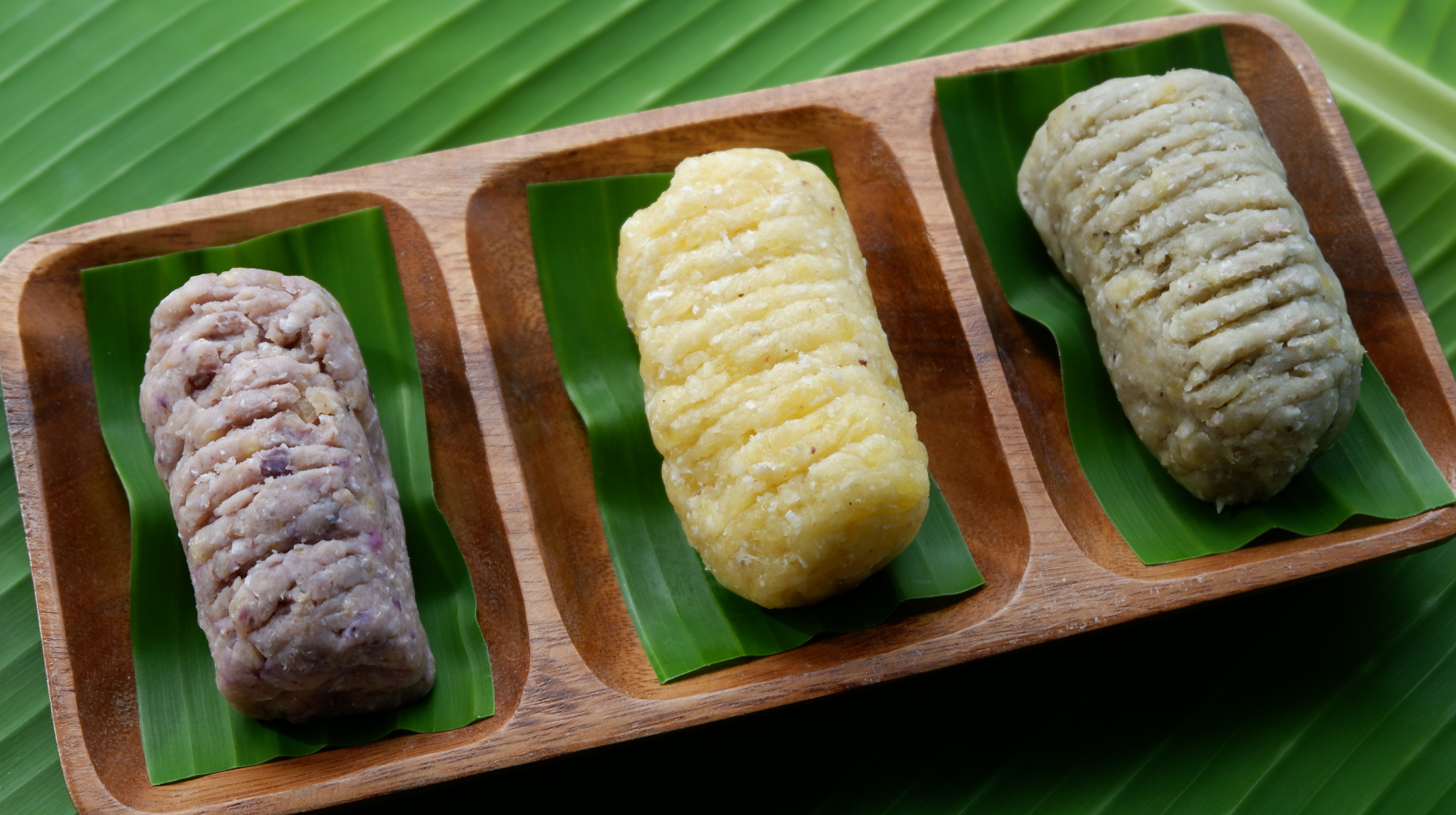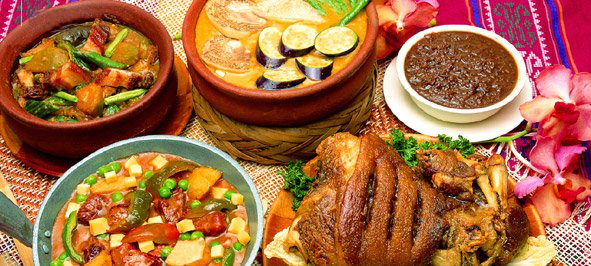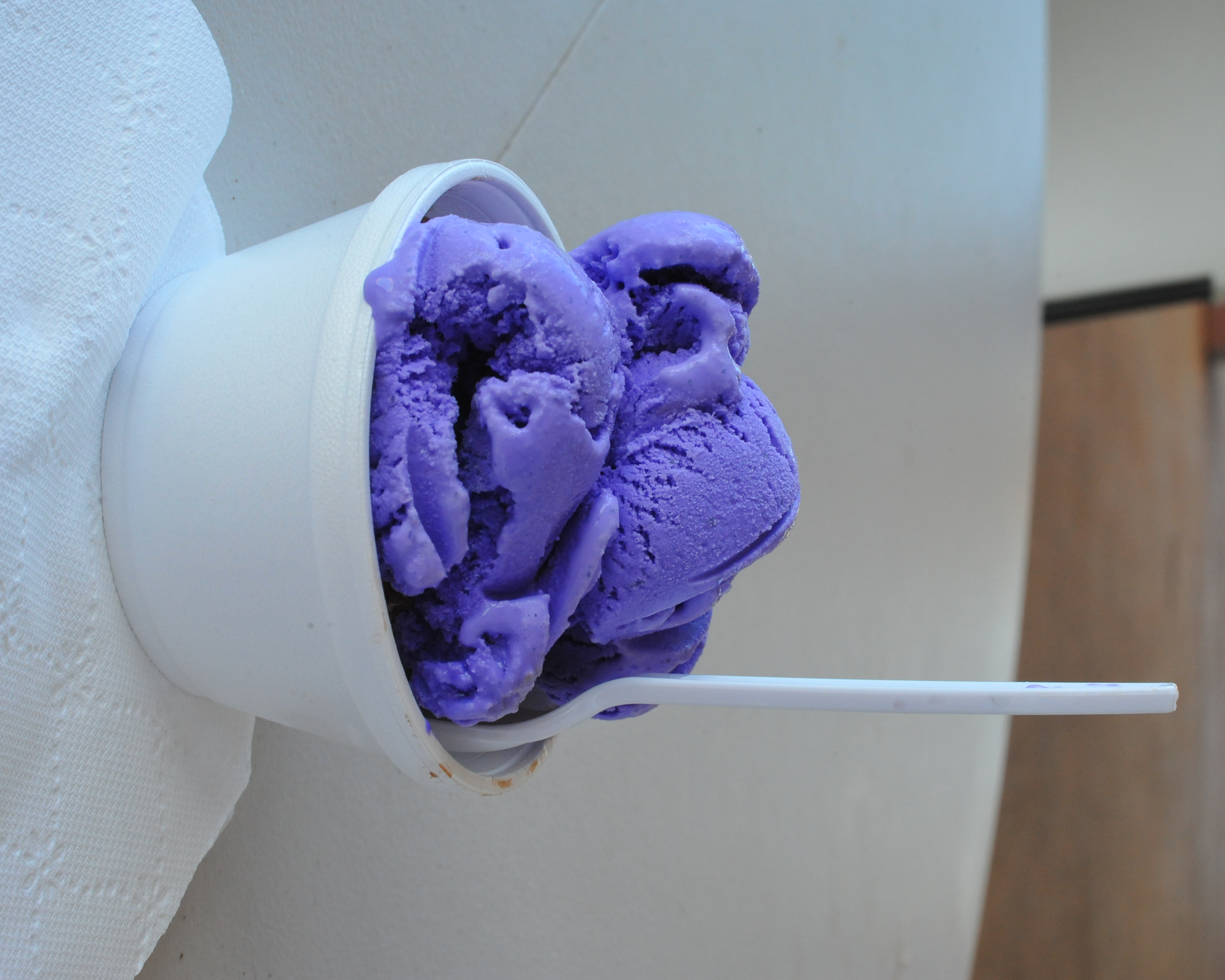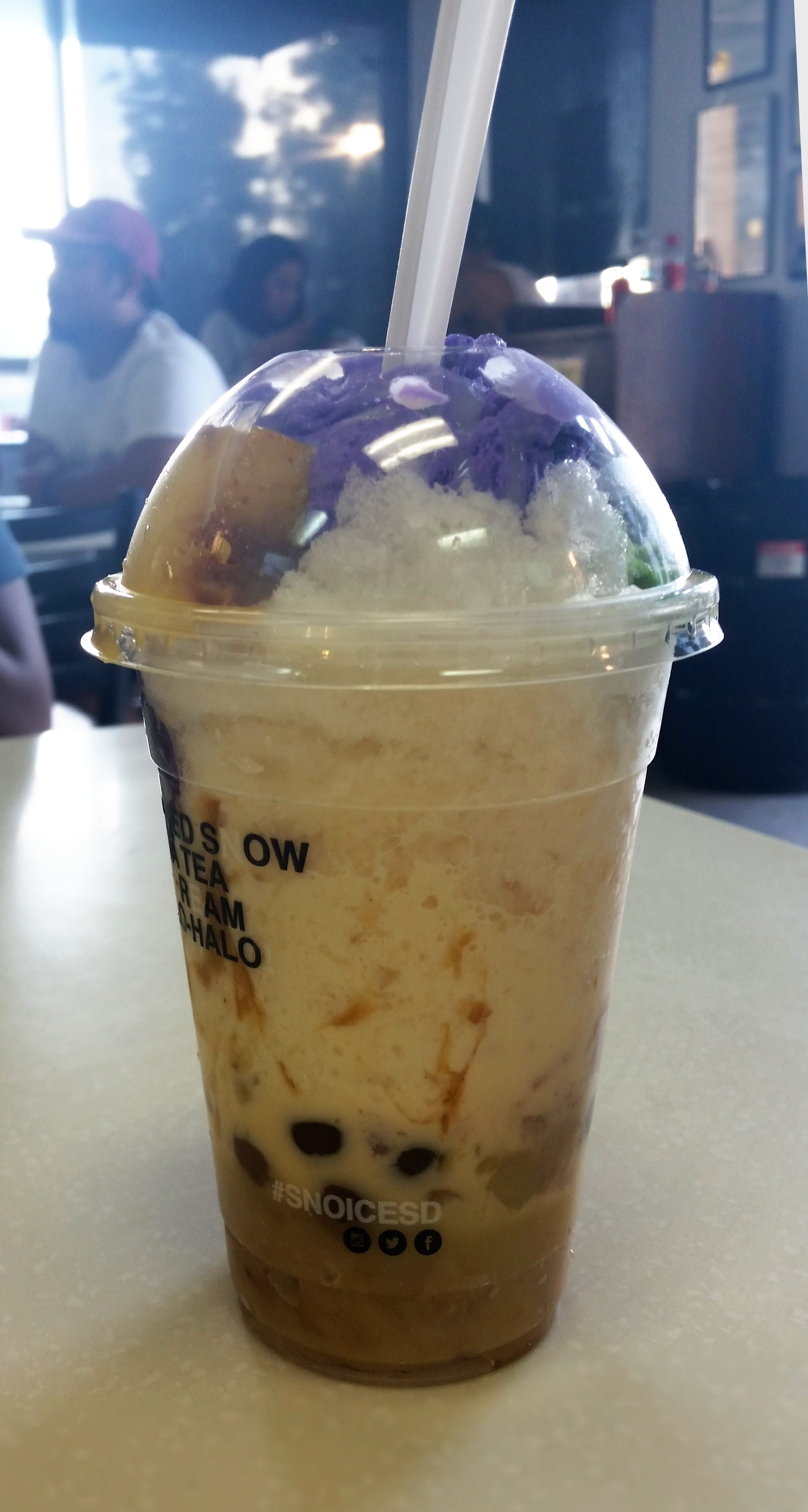|
Halaya
''Ube halaya'' or ''halayang ube'' (also spelled ''halea'', ''haleya''; ) is a Filipino dessert made from boiled and mashed purple yam (''Dioscorea alata'', locally known as ''ube''). Ube halaya is the main base in ube/purple yam flavored-pastries and ube ice cream. It can also be incorporated in other desserts such as ''halo-halo''. It is also commonly anglicized as ube jam, or called by its original native name, ''nilupak na ube''. History The Philippines shows the highest phenotypic diversity of ube (''Dioscorea alata''), making it one of the likely centers of origin of ube domestication. Remains of ube have been recovered from the Ille Cave archaeological site of Palawan (c. 11,000 BP). Preparation The main ingredient is peeled and boiled purple yam which is grated and mashed. The mashed yam, with condensed milk (originally sweetened coconut milk), are added to a saucepan where butter or margarine had been melted. The mixture is stirred until thickened. Once thickened, t ... [...More Info...] [...Related Items...] OR: [Wikipedia] [Google] [Baidu] |
Nilupak
Nilupak is a class of traditional Filipino delicacies made from mashed or pounded starchy foods mixed with coconut milk (or condensed milk and butter) and sugar. They are molded into various shapes and traditionally served on banana leaves with toppings of grated young coconut (''buko''), various nuts, cheese, butter, or margarine. It is also known as nilusak, linusak, niyubak, linupak, or lubi-lubi, among many other names, in the various languages of the Philippines. It is also known as minukmok in Quezon. Names The term ''nilupak'' means "mashed" or "pounded", from the Tagalog verb ''lupak'', "to pound nto a pulp(with a mortar and pestle)". It is also known as ''nilusak'' in Visayan regions with the same meaning. They were traditionally pounded in large stone or wood mortar and pestle. In Philippine Spanish, ''nilupak'' was known as ''jalea'' ("jam"), which became spelled as '' halaya'', ''haleya'', or ''halea'' in the native languages. This term is especially used for ' ... [...More Info...] [...Related Items...] OR: [Wikipedia] [Google] [Baidu] |
Filipino Cuisine
Filipino cuisine is composed of the cuisines of more than a hundred distinct Ethnic groups in the Philippines, ethnolinguistic groups found throughout the Philippines, Philippine archipelago. A majority of mainstream Filipino dishes that comprise Filipino cuisine are from the food traditions of various ethnolinguistic groups and tribes of the archipelago, including the Ilocano people, Ilocano, Pangasinan people, Pangasinan, Kapampangan people, Kapampangan, Tagalog people, Tagalog, Bicolano people, Bicolano, Visayan, Chavacano, and Maranao people, Maranao ethnolinguistic groups. The dishes associated with these groups evolved over the centuries from a largely indigenous (largely Austronesian peoples, Austronesian) base shared with maritime Southeast Asia with varied influences from Chinese cuisine, Chinese, Spanish cuisine, Spanish, and American cuisine, American cuisines, in line with the major waves of influence that had enriched the cultures of the archipelago, and adapted us ... [...More Info...] [...Related Items...] OR: [Wikipedia] [Google] [Baidu] |
Ube Cake
Ube cake is a traditional Filipino chiffon cake or sponge cake made with ube halaya (mashed purple yam). It is distinctively vividly purple in color, like most dishes made with ube in the Philippines. Preparation Ube cake is generally prepared identically to mamón (chiffon cakes and sponge cakes in Filipino cuisine), but with the addition of mashed purple yam to the ingredients. It is typically made with flour, eggs, sugar, a dash of salt, baking powder, vanilla, oil, milk, and cream of tartar. The resulting cake is pink to purple in color (depending on the amount of ube used) and slightly denser and moister than regular chiffon cakes. Ube cake typically has a whipped cream, cream cheese, or buttercream frosting, which may also be flavored with ube or coconut. Variations Like mamón, ube cake can be modified readily into other recipes. Ube macapuno cake The combination of ube and macapuno (coconut sport) is a traditional one for ube halaya in Filipino cuisine, and it also ... [...More Info...] [...Related Items...] OR: [Wikipedia] [Google] [Baidu] |
Purple Yam
''Dioscorea alata''also called ube (), ubi, purple yam, or greater yam, among many other namesis a species of yam (a tuber). The tubers are usually a vivid violet-purple to bright lavender (hence the common name), but some range from creamy-white to plain white. It is sometimes confused with taro and the Okinawa sweet potato (''Ipomoea batatas'' ' Ayamurasaki'), however ''D. alata'' is also grown in Okinawa. Its origins are in the Asian and Oceanian tropics. Some varieties attain to great size. A "Mambatap" greater yam grown in Maprik, East Sepik District, Papua New Guinea around 1939 was in length. Names Because it has become naturalized following its origins in Asia, specifically the Philippines, through tropical South America, and the southeastern United States, ''D. alata'' is referred to by many different names in these regions. In English alone, aside from purple yam, other common names include ten-months yam, water yam, white yam, winged yam, violet yam, Guyana arr ... [...More Info...] [...Related Items...] OR: [Wikipedia] [Google] [Baidu] |
Ube Ice Cream
Ube ice cream is a Filipino cuisine, Filipino ice cream flavor prepared using Dioscorea alata, ube (purple yam, not to be confused with taro/purple sweet potato) as the main ingredient. The ice cream is often used in the making of the dessert halo-halo. History Due to its vivid violet color and mildly sweet and nutty taste, Dioscorea alata, ube has been a staple of Filipino desserts, most notably ube halaya. The earliest recorded use of ube in ice cream was in a recipe from 1922, when ice cream's introduction to Filipino culture during the History of the Philippines (1898–1946), American occupation (as the local adaptation sorbetes) led to new flavors like mango, pinipig, and melon. The recipe called for mashed ube, milk, sugar, and crushed ice. During that time, ice cream was also hand-churned in a ''garapinyera'', a manually operated Ice cream maker#Hand-cranked machines, ice cream mixer. Ube ice cream has risen in popularity outside the Philippines, due to its use by Ov ... [...More Info...] [...Related Items...] OR: [Wikipedia] [Google] [Baidu] |
Halo-halo
''Haluhalo'' is a popular cold dessert in the Philippines made with crushed ice, evaporated milk or coconut milk, and various ingredients including side dishes such as ube jam (ube halaya), sweetened kidney beans or garbanzo beans, coconut strips, sago, '' gulaman'' (agar), pinipig, boiled taro or soft yams in cubes, flan, slices or portions of fruit preserves, and other root crop preserves. The dessert is topped with a scoop of ube ice cream. It is usually prepared in a tall clear glass and served with a long spoon. ''Haluhalo'' is considered to be the unofficial national dessert of the Philippines. ''Haluhalo'' is more commonly spelled as "''halo-halo''", but the former is the official spelling in the Commission on the Filipino Language's dictionary. The word is an adjective meaning "mixed ogether in Tagalog. It is a reduplication of the Tagalog verb ''halo'', which means "to mix". History The origin of ''haluhalo'' is traced to the pre-war Japanese Filipinos ... [...More Info...] [...Related Items...] OR: [Wikipedia] [Google] [Baidu] |
Ube Macapuno
Buko salad, usually anglicized as young coconut salad, is a Filipino fruit salad dessert made from strips of fresh young coconut (''buko'') with sweetened milk or cream and various other ingredients. It is one of the most popular and ubiquitous Filipino desserts served during celebrations and '' fiestas''. By changing the ratio of milk, ''buko salad'' desserts can also become beverages (usually chilled or with shaved ice), known generally as ''samalamig''. A frozen dessert version of the dish is known as ice buko. Variants Buko salad can have many variations as it can incorporate numerous other ingredients ranging from fruits, ''gulaman'' (agar) jellies, sago, kaong, tapioca pearls, ''nata de coco'', macapuno, and others. Some versions however are popular enough to be considered as distinct subtypes. They include: Buko halo Buko halo or buko halo-halo is a combination of buko salad and '' halo-halo'' desserts, usually served directly on a coconut shell. It differs from ... [...More Info...] [...Related Items...] OR: [Wikipedia] [Google] [Baidu] |
Macapuno
Macapuno, also called coconut sport, is a naturally occurring coconut cultivar that has an abnormal development of the endosperm. The result of this abnormal development is a soft translucent jelly-like flesh that fills almost the entire central cavity of coconut seeds, with little to no coconut water. Macapuno was first described scientifically from wild specimens in 1931 by Edwin Copeland. They were cultivated commercially in the Philippines after the development of the "embryo rescue" ''in vitro'' culture technology in the 1960s by Emerita V. De Guzman. Although called coconut sport, this mutation is not necessarily a sport in the botanical sense of a mutation arising in part of an adult plant; it may have arisen originally in a seed. It has become an important crop in coconut-producing countries and is now widely used in the cuisines of Southeast Asia and the Pacific Islands. Name The name ''macapuno'' (also spelled ''makapuno'') is derived from Tagalog , the local name ... [...More Info...] [...Related Items...] OR: [Wikipedia] [Google] [Baidu] |
Taro Purée
Taro purée, also known as taro mash or taro paste, () is a traditional dessert in Fujianese cuisine and Teochew cuisine. Made from puréed taro and lard and served on a flat plate, the dessert is normally topped with toasted sesame seeds, and occasionally with candied ginkgo, red dates, or melon seeds. See also * List of Chinese desserts * Poi (food) References {{food-stub Purée A purée (or mash) is cooked food, usually vegetables, fruits or legumes, that has been ground, pressed, blended or sieved to the consistency of a creamy paste or liquid. Purées of specific foods are often known by specific names, e.g., appl ... Chinese desserts ... [...More Info...] [...Related Items...] OR: [Wikipedia] [Google] [Baidu] |
Binagol
''Binagol'' is a Filipino sweet steamed delicacy of the Waray people made from mashed giant taro corms, condensed milk, sugar, coconut milk, and egg yolks. It is distinctively placed in half of a coconut shell and then wrapped in banana leaves and twine. The name means "placed in a coconut shell", from the Visayan ''bagol'' (coconut shell). ''Binagol'' traditionally uses the corms of the giant taro (locally known as ''talyan'' or ''talian''); however, the corms of the taro (known in Tagalog as ''gabi'' and in Eastern Visayas, where the delicacy originates, as ''gaway'') is also alternatively used. It is a type of '' nilupak''. See also * Kalamay * Moron (food) * Ube halaya ''Ube halaya'' or ''halayang ube'' (also spelled ''halea'', ''haleya''; ) is a Filipino cuisine, Filipino dessert made from boiled and mashed purple yam (''Dioscorea alata'', locally known as ''ube''). Ube halaya is the main base in ube/purple ... References {{Philippine cuisine Foods containing ... [...More Info...] [...Related Items...] OR: [Wikipedia] [Google] [Baidu] |
Kalamay Ube
''Kalamay'' (also spelled ''calamay'', literally "sugar") is a sticky sweet delicacy that is popular in many regions of the Philippines. It is made of coconut milk, brown sugar, and ground glutinous rice. It can also be flavored with margarine, peanut butter, or vanilla. ''Kalamay'' can be eaten alone, but is usually used as a sweetener for a number of Filipino desserts and beverages. It is related to the Chamorro dessert called kalamai. Preparation ''Kalamay'' is made by extracting coconut milk from grated coconuts twice. Glutinous rice is added to the first batch of coconut milk and the mixture is ground into a paste. Brown sugar is added to the second batch of coconut milk and boiled for several hours to make '' latík''. The mixture of ground glutinous rice and coconut milk is then poured into the ''latík'' and stirred until the consistency becomes very thick. It can be served hot or at room temperature especially when eaten with other dishes. Viscous ''kalamay'' are of ... [...More Info...] [...Related Items...] OR: [Wikipedia] [Google] [Baidu] |







